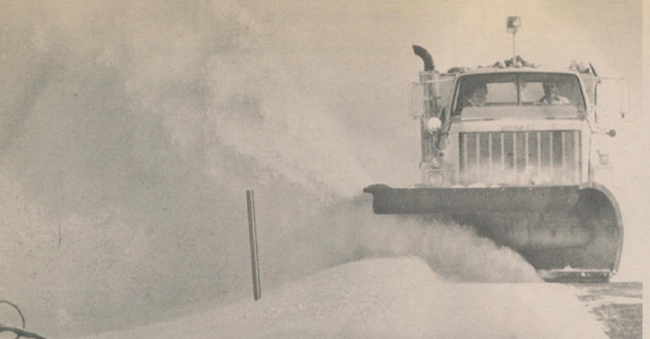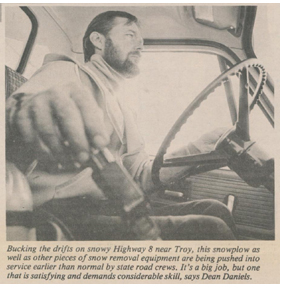

From ITD Vault: 30 Years Ago (Jan. 1986)
Moving snow demands the proper touch
Highway reflectors whip by in a wink. A sudden jerk of the steering wheel, a moment of inattention and the 12-foot snowplow blade would mow them down like wheat.
But Dean Daniels rumbles down Highway 95 toward Genesee, his diesel truck pushed by 295 horsepower, weighted down with eight cubic yards of sand and dispensing it from the rear, the plow blade roaring as it bites into a drift along the road shoulder, and the reflector posts flash by inches away.
There is precision involved in this business of plowing snow. Daniels has been working for the Idaho Transportation Department 23 years. He has plowed snow throughout the state and heads up the nine-man crew working out of Moscow this winter. During a storm, this group plows and sands continuously Highway 95 from Viola to Genesee, the Pullman-Moscow Highway and Highway 8 from Moscow to Troy.
One lap of the route takes two and a half hours to complete, and snow plowers work 12-hour shifts.
"Seven days a week, 24 hours a day, we're covered," he said. "I've had two Christmases off in 23 years."
When time permits, Daniels likes to swap crew members between Moscow and Potlatch, so they become familiar with conditions in each area.
"There is heavier snow and narrower roads in the Potlatch area. You've got heavier traffic in the Moscow area," he said.
Snow plowers have two major complaints: cars that tuck right in behind the sanding truck, and a melting snow floor. Fearful that flying gravel will break a windshield, snow plowers stop sanding when oncoming traffic approaches or when a vehicle follows closely behind in the erroneous belief traction is better there.
On and off sanding is annoying. A melting snow floor is dangerous.
If it melts unevenly there will be patches of soft snow mixed with harder stuff. A blade may ride through one kind but catch on the other. Should it happen "it will throw you right across the road," Daniels said.
Because they work throughout a storm, snow plowers frequently find themselves trying to plow at night in zero visibility.
"We can't see any better than anyone else," Daniels said. And while they try to plow close to the road shoulder, should the drivers get the width of a tire over the shoulder they'll plow right into a ditch.
"They're just trucks. They have no better traction than any other truck this size. They're not something super-human," said Daniels.
An oncoming snowplow throwing a white plume high over its right side looks as though it is creating its own storm. Within this mobile blizzard much is happening.
At any moment, the operator is paying as much attention to the snowy or icy road as any driver; he has a $70,000 rig in his care. He is watching the blade in relation to the road's edge and obstacles like reflector posts, mailboxes and bridge abutments. He is looking for oncoming and following traffic and working the PTO switch on the sander accordingly. He moves the blade up or down as the snow covering the road varies in depth. And he must be aware of railroad tracks crossing his path that could snag the blade.
The truck transmission growls and the blade sweeping across pavement roars. The whole scene could be taking place towards the end of a 12-hour shift, in the dark in a snowstorm.
From behind the wheel of a truck working its way toward Genesee, Daniels turns and grins.![]()
"It takes a lot of coffee and cigarettes to get through this," he shouts over the noise.
The job isn't made up entirely of tedium and stress, however. Plowing into Troy, with snow bearing down the branches of pines, is breathtaking. After a storm, snow plowers are among the first to get around the county to see how people have coped. And it is satisfying to keep the roads clear, Daniels said.
"I enjoy plowing snow anytime, except when we have reduced visibility," he said. "I think all of the members of my crew enjoy snow removal. It's challenging for everybody. It's rewarding, at the same time, to have safe travel conditions.
"I've seen some beautiful times plowing snow through the years. In 1968, I was plowing by Fairfield Christmas Day. We had about 12 inches of snow, the road was closed, and I was the first vehicle through. The snow was drifting, and with the overhanging drifts, it was beautiful."
Editor’s 2015 note: This story and pictures are courtesy of The Idahonian, which served north-central Idaho until 1991, when the newspaper began publishing as the Moscow-Pullman Daily News. After 36 years of service, Daniels retired in 1998 as the transportation technician principal-foreman for the Moscow-Potlatch area. He passed away in July 2014 at age 71. The $70,000 cost of a snowplow as reported in this story is now in excess of $230,000 on average, but one thing hasn't changed much in the three decades since this story - snowplow drivers are still, by and large, a unique breed.
Published 01-22-16